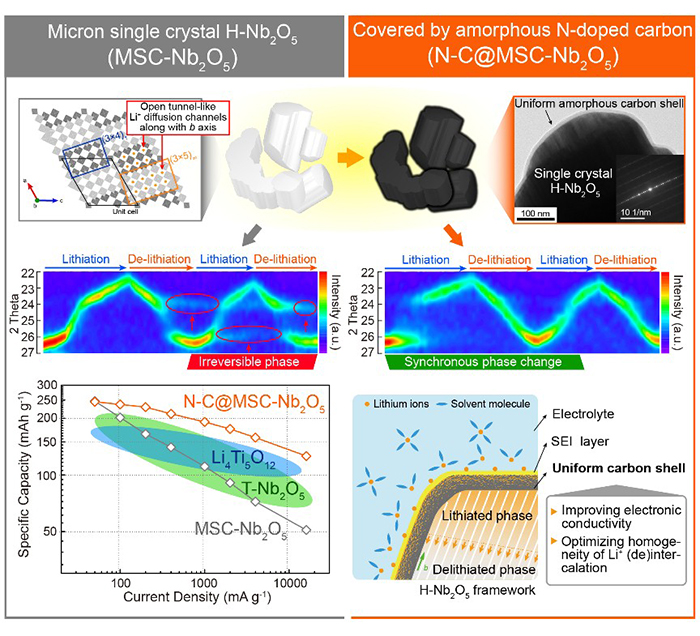A research group led by Prof. LI Xianfeng, Prof. ZHANG Huamin and Prof. ZHANG Hongzhang from the Dalian Institute of Chemical Physics (DICP) of the Chinese Academy of Sciences (CAS), in collaboration with Prof. TANG Yongfu from Yanshan University, developed a high-rate anode material for lithium ion battery (LIB).The results were published in Advanced Materials.
Niobium pentoxide (Nb2O5) possesses a high specific capacity and fast Li storage kinetics in a safe operating potential window, which is suitable for high-rate battery systems. H-Nb2O5 exhibits the highest specific capacity of >250 mAh/g (1.0~3.0 V vs Li+/Li) among most configurations of Nb2O5.
However, the crystal structure of H-Nb2O5 would change during Li+ (de)intercalation, accompanied with the generation of certain irreversible and inactive phase. That is the main hinderance of H-Nb2O5 anodes in practical applications for LIBs.

Schematic of the performance improvement strategy for H-Nb2O5 as a high-rate anode material for LIBs. (Image by SONG Zihan)
The scientists in DICP found that optimizing homogeneity of electron and Li-ion transports surrounding the crystals was proposed to act a great role of improving the capacity and cycling life at high rates. An amorphous N-doped carbon layer is introduced on the micrometer single-crystal H-Nb2O5 particle (N-C@MSC-Nb2O5) to optimize the homogeneity of phase transition and to suppress the irreversible structure changes.
Therefore, N-C@MSC-Nb2O5 exhibits a long cycling life of over 1000 charge/discharge cycles at a high current density of 2000 mA/g, which is 10 times longer than that of pristine H-Nb2O5.
Moreover, N-C@MSC-Nb2O5 also shows a better rate performance than Li4Ti5O12-based and other Nb2O5-based anode materials. In addition, the inherent principle is further con?rmed via operando transmission electron microscopy (TEM) and X-ray diffraction (XRD).
This work was supported by Youth Innovation Promotion Association of CAS, National Natural Science Foundation of China, National Key Research and Development Project, Dalian National Laboratory for Clean Energy and Dalian Science and Technology Star Program. (Text by SONG Zihan)